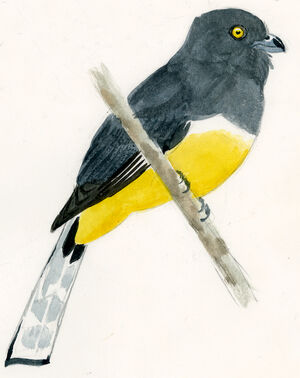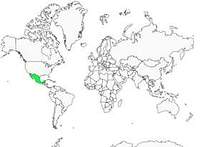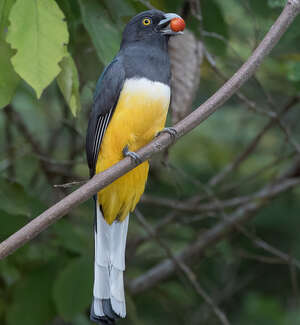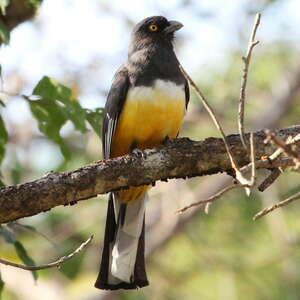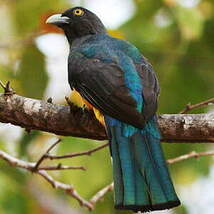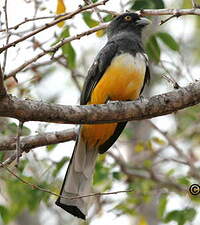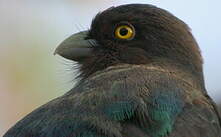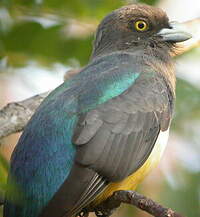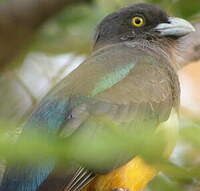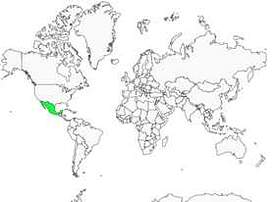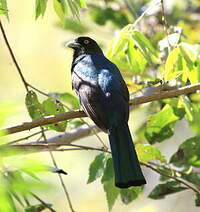Citreoline Trogon
Trogon citreolus - Trogon citrin
Identification
The Citrine Trogon, Trogon citreolus, in Latin, was aptly named by British ornithologist John Gould (1804-1881). It is very similar to the White-tailed Trogon, Baird's Trogon, and the Black-headed Trogon, all of which make up a super-species. It is a typical trogon size-wise at 27 cm, and the male/female dimorphism is less pronounced compared to some other species. When viewed from the front, the male has a light blue beak, the upper jaw being very pale, the whole head is a gray-anthracite color, with faint "ear coverts", a bright yellow iris, and a distinguishing feature from the female of the Lesser Green Trogon, Violaceous Trogon, or a Black-headed Trogon couple. The throat and breast are the same color as the head - gray-anthracite - and a light white line separates the chest from the brilliantly yellow-citron underbelly. The mantle and back are emerald-green, turning to metallic blue on the lower back and rump. The green scapulars contrast against the dark gray coverts, the remiges the same color also possessing white fringes - a characteristic found in many trogons. The feathers underneath are white, the bird also having two small black marks at the base of the first pair of rectrices, just below the belly. A thin, dark line is visible in the center of the white rectrices, and the tail ends with a horizontal black line. On the upper rectrices, the emerald green color is duller than the mantle. Central rectrices have green-bronze highlights, the tail always showing the horizontal black line at the tip. Females viewed from the front show few differences, their beak is much paler, the tip of the upper jaw being black. Both sexes maintain a yellow iris, with the head, nape, and chest all being gray, the light white line separating the latter from the light yellow underbelly is much wider.The mantle, back and shoulders are grey, the coverts are also grey shaded with extremely thin white vermiculations and sometimes barely visible depending on the individual; the darker colored remiges retain the white edgings of the male. It is undeniably the tail that will distinguish her from her companion, the lower rectrices are distinctly black at their base, the last pair showing a fairly clear black diamond at its birth and ending with a horizontal black line. The upper rectrices take on the same grey coloring as the mantle and back. The tarses are blue-grey. The young resemble their mother, the coverts are marked with white spots, the belly is yellowish-white which will yellow with age, the rectrices are much darker, and the dark brown eye has not yet developed the yellow iris. Two ssp are recognized, citreolus which is the nominal species and sumichrasti, larger, 29 cm, whose outermost rectrices show white borders; the difference between the two ssp is very minimal and hardly visible, especially since they hybridize.
Subspecific information 2 subspecies
- Trogon citreolus citreolus (w Mexico)
- Trogon citreolus sumichrasti (s Mexico)
Foreign names
- Trogon citrin,
- Trogón citrino,
- surucuá-citrino,
- Graukopftrogon,
- Grijskoptrogon,
- Trogone citrino,
- citrontrogon,
- Guløyetrogon,
- trogón citrónový,
- trogon žlutobřichý,
- Guløjet Trogon,
- sitruunatrogoni,
- trogon citrí,
- trogon cytrynowy,
- Сероголовый трогон,
- ウスハグロキヌバネドリ,
- 黄纹美洲咬鹃,
- citrontrogon,
- 黃紋美洲咬鵑,
Voice song and call
Habitat
The Citreoline Trogon is the host of deciduous or semi-deciduous forests, as well as semi-forested areas. It is usually found in scrubby terrain and forests of acacia and other thorns, tropical forests along the Pacific coast in the states of Jalisco and Nayarit. Near the mangroves and water sources, it is not an altitude enthusiast and can not be seen more than 1000 m.
Dietfeeding habits
As with all trogonids, the Citreoline Trogon is frugivorous and insectivorous. In the dry season, from February to June, it will be particularly interested in the fruits and berries of acacias, caeserias, and various ficuses. From July to October, it will easily find insects, caterpillars and various larvae. Its diet will necessarily follow that of its young, which are exclusively insectivorous.
Reproduction nesting
From May to August, the Citreoline Trogon builds its nest in an old tree-termite nest, specifically in the family of Nasutitermité at a height of 5 to 6 m. The clutch is 2 to 4 eggs. There is very little information on incubation, the feeding of the chicks and the flight period. It is likely that the reproduction of the Citreoline Trogon is similar to that of the Black-headed Trogon, its cousin who lives mainly in the center and on the east coast of Mexico.
Geographic range
Threats - protection
Sources of information
- IOC World Bird List (v15.1), Gill, F and D Donsker (Eds). 2025-12-07.
- A Natural history of the Trogonidae, Joseph M.Forshaw Albert Earl Gilbert
- A Guide to the Birds of Mexico and Northern Central America, Steve N. G. Howell, Sophie Webb
- Vol. 6 - Handbook of the Birds of the World, Josep del Hoyo-Andrew Elliott-Jordi Sargatal
- xeno-canto, Sharing bird sounds from around the world,
- Avibase, Lepage Denis
- BirdLife International, BirdLife International
- Wikipédia, Wikipedia, The Free Encyclopedia
Other sources of interest
 Specification sheet created on
04/08/2023 by Anne et Gabriel Leboff
Specification sheet created on
04/08/2023 by Anne et Gabriel LeboffTranslation by AI Oiseaux.net
© 1996-2025 Oiseaux.net
- Accipitriformes
- Aegotheliformes
- Anseriformes
- Apodiformes
- Apterygiformes
- Bucerotiformes
- Caprimulgiformes
- Cariamiformes
- Casuariiformes
- Charadriiformes
- Ciconiiformes
- Coliiformes
- Columbiformes
- Coraciiformes
- Cuculiformes
- Eurypygiformes
- Falconiformes
- Galliformes
- Gaviiformes
- Gruiformes
- Leptosomiformes
- Mesitornithiformes
- Musophagiformes
- Nyctibiiformes
- Opisthocomiformes
- Otidiformes
- Passeriformes
- Pelecaniformes
- Phaethontiformes
- Phoenicopteriformes
- Piciformes
- Podargiformes
- Podicipediformes
- Procellariiformes
- Psittaciformes
- Pterocliformes
- Rheiformes
- Sphenisciformes
- Steatornithiformes
- Strigiformes
- Struthioniformes
- Suliformes
- Tinamiformes
- Trogoniformes

